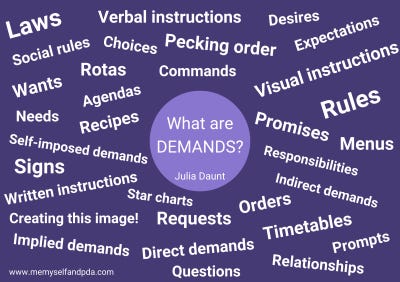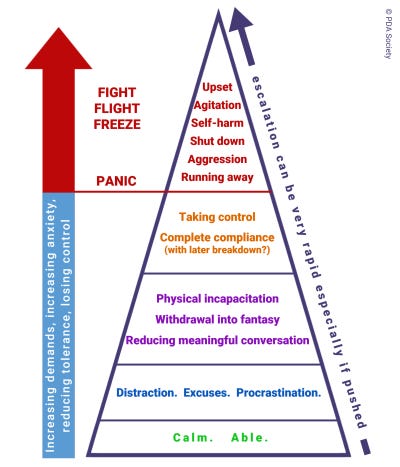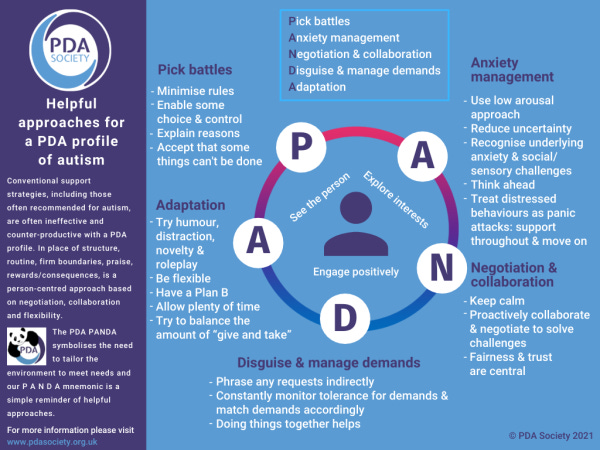Pathological Demand Avoidance
A post discussing what Pathological Demand Avoidance is and how it presents in my life as an autistic person.
Pathological Demand Avoidance is another term where I take umbrage with the name, so I will be referring to it as PDA or Demand Avoidance throughout this piece. “Calling this resistance ‘pathological’ rests firmly on the ableist preferences and values of the person whose demands are not being met.” Some also refer to it as Extreme Demand Avoidance (EDA) and Demand Avoidance Phenomena (DAP).
PDA is not recognized in the DSM-5, so even though the term was created in the 1980s, it is still controversial. "[T]here has been much debate between professionals as to whether this is indeed a separate condition or whether the behaviours found in PDA can be explained within other disorders such as attachment disorder or personality disorder or a female form of autism.”
It is so closely connected to Autism that some consider it a subtype of Autism Spectrum Disorder. “Autistic people may avoid demands or situations that trigger anxiety or sensory overload, disrupt routines, involve transitioning from one activity to another, and activities/events that they don’t see the point of or have any interest in. They may refuse, withdraw, ‘shutdown’ or escape in order to avoid these things.”

Demand Avoidance is an “extreme” resistance and avoidance of “ordinary” demands and requests even when complying may be in your best interest.
External: imposed by others, like a deadline or an instruction from a teacher.
Internal: imposed by yourself, like a plan you’ve decided to follow.
Explicit: such as a direct demand.
Implicit: such as a polite request or unsaid expectation.

Image courtesy of Julia Daunt via the PDA Society
Another part of it is that the resistance is anxiety-driven. "[S]ome argue that demand avoidance may be described as a rational method of avoiding anxiety, especially for those with limited autonomy, such as children. However, the procrastination or avoidance of tasks ultimately increases anxiety which can create a continual cycle of anxiety & avoidance.
Demand Avoidance can present as impulsivity, mood swings, and being unable to do things at specific times. “Children with PDA feel threatened when they are not in control of their environment and their actions, triggering the fight, flight, or freeze response and resulting in behavior such as opposition, resistance, defiance, arguing, and aggression.” Demand Avoidance is associated with trauma and adverse childhood experiences and some believe it is actually caused by trauma.
If I was just about to make my bed but someone suggested I do it before I start that task I will immediately not want to acquiesce with the recommendation because it no longer feels like my decision but that I have to comply with someone else’s demand regardless of whether or not I also wanted to do that action prior to the commentary. Because I was forced to do so many things as a child that stripped me of my autonomy, I rail against anything that feels remotely near that territory. If something doesn’t completely feel like my choice, or I feel external pressure to do something, my brain is immediately opposed to the idea as it remembers all the times I was previously forced to do things I was uncomfortable with against my will.
My PDA does not allow me to process the request in a way that aligns with my comfort and safety so it views the obligation as a threat. However, my Demand Avoidance is not constant or consistent as I am capable of sometimes doing things others have requested of me especially if the “demand” has been presented in such a way that my well-being does not feel like it will be negatively impacted by complying. I could not specify exactly what is required for me to consent and conform just as I am unable to accurately communicate what requests will trigger my Demand Avoidance.
I do believe that when I am already anxious, stressed, or my PTSD triggered that I am more likely to procrastinate and avoid demands. “We know that as a person becomes distressed, they tend to express more Restricted and repetitive behaviours and interests (RRBIs) increase and especially are associated to trauma.” So knowing that, it seems logical that instead of requesting more of people with PDA in an already heightened emotional state removing demands and obligations would be a better option to help that person regulate before the next task at hand.

Recommendations on how to handle PDA vary depending on whether you are in a parent/child relationship or if you are an adult with Demand Avoidance. “Despite the links between autism and EDA…, previous work suggests that approaches recommended for autism (such as establishing routine and structure) can be counterproductive in cases of clear EDA.”
Recommendations for People Supporting Someone with PDA:
Be flexible. Have alternative arrangements as a backup.
Offer options so it feels like a choice.
Adjust your mindset about a parent/authority relationship with a child. Become collaborators instead of adversaries.
Reduce demands or the perception of demands. Rephrasing requests may be helpful.
Give plenty of prior notice before upcoming obligations. Too many reminders can feel nagging though.
Choose your battles. Limit unnecessary rules.
Set mutually agreed-upon expectations through open and honest dialogue discussing each of your needs.
Consider a Low Arousal Approach.

Recommendations for People with PDA:
Recognize your demand avoidance.
Determine your triggers.
Understand what “demands” work for you.
Explore alternative options to obligations.
Ask for accommodations when needed.
Communicate (as openly as possible) about your PDA to people who make “demands” of you.
Have “demand-free” time in your routine.
Learn to regulate sensory overload and your emotional state.
Reduce your stress levels.
Relieve anxiety.
Do further exploration of PDA to gain self-acceptance and learn more coping techniques.
Even though there is not yet an official consensus on how to diagnose Demand Avoidance, it resonated so deeply within me when I learned about it that I believe I have PDA. I only got a 46 on the Extreme Demand Avoidance Questionnaire for Adults, but when you know you have PDA, you know.
Do you experience Demand Avoidance? If so, how does it present in your life?
~The Overstimulated




